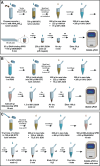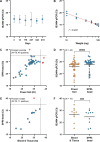A low-cost and versatile paramagnetic bead DNA extraction method for Mycobacterium ulcerans environmental surveillance
- PMID: 39254328
- PMCID: PMC11497799
- DOI: 10.1128/aem.01021-24
A low-cost and versatile paramagnetic bead DNA extraction method for Mycobacterium ulcerans environmental surveillance
Abstract
In Australia, native possums are a major wildlife reservoir for Mycobacterium ulcerans, the causative agent of the neglected tropical skin disease Buruli ulcer (BU). Large-scale possum excreta surveys that use PCR to detect M. ulcerans in 100-1,000 s of excreta specimens are an important tool that can inform geospatial modeling and predict locations of future human BU risk. However, the significant expense of commercial kits used to extract DNA from specimens is a major barrier to routine implementation. Here, we developed a low-cost method for DNA extraction from possum excreta, possum tissue, and pure mycobacterial cultures, using a guanidinium isothiocyanate lysis solution and paramagnetic beads. In a 96-well plate format for high-throughput processing, the paramagnetic bead DNA extraction method was threefold less sensitive but only 1/6 the cost of a commonly used commercial kit. Applied to tissue swabs, the method was fourfold more sensitive and 1/5 the cost of a commercial kit. When used for preparing DNA from pure mycobacterial cultures, the method yielded purified genomic DNA with quality metrics comparable to more lengthy techniques. Our paramagnetic bead method is an economical means to undertake large-scale M. ulcerans environmental surveillance that will directly inform efforts to halt the spread of BU in Victoria, Australia, with potential for applicability in other endemic countries.
Importance: Buruli ulcer (BU) is a neglected tropical skin disease, with an incidence that has dramatically increased in temperate southeastern Australia over the last decade. In southeastern Australia, BU is a zoonosis with native possums the major wildlife reservoir of the causative pathogen, Mycobacterium ulcerans. Infected possums shed M. ulcerans in their excreta, and excreta surveys using PCR to screen for the presence of pathogen DNA are a powerful means to predict future areas of Buruli ulcer risk for humans. However, excreta surveys across large geographic areas require testing of many thousands of samples. The cost of commercial DNA extraction reagents used for preparing samples for PCR testing can thus become prohibitive to effective surveillance. Here, we describe a simple, low-cost method for extracting DNA from possum excreta using paramagnetic beads. The method is versatile and adaptable to a variety of other sample types including swabs collected from possum tissues and pure cultures of mycobacteria.
Keywords: Australian native possums; Buruli ulcer; DNA extraction; Mycobacterium ulcerans; paramagnetic beads.
Conflict of interest statement
The authors declare no conflict of interest.
Figures


Similar articles
-
Statistical modeling based on structured surveys of Australian native possum excreta harboring Mycobacterium ulcerans predicts Buruli ulcer occurrence in humans.Elife. 2023 Apr 14;12:e84983. doi: 10.7554/eLife.84983. Elife. 2023. PMID: 37057888 Free PMC article.
-
Clinical, microbiological and pathological findings of Mycobacterium ulcerans infection in three Australian Possum species.PLoS Negl Trop Dis. 2014 Jan 30;8(1):e2666. doi: 10.1371/journal.pntd.0002666. eCollection 2014. PLoS Negl Trop Dis. 2014. PMID: 24498451 Free PMC article.
-
Buruli ulcer surveillance in south-eastern Australian possums: Infection status, lesion mapping and internal distribution of Mycobacterium ulcerans.PLoS Negl Trop Dis. 2024 Nov 5;18(11):e0012189. doi: 10.1371/journal.pntd.0012189. eCollection 2024 Nov. PLoS Negl Trop Dis. 2024. PMID: 39499725 Free PMC article.
-
Epidemiology of Buruli Ulcer in Victoria, Australia, 2017-2022.Emerg Infect Dis. 2025 Mar;31(3):448-457. doi: 10.3201/eid3103.240938. Emerg Infect Dis. 2025. PMID: 40023793 Free PMC article. Review.
-
What about Current Diversity of Mycolactone-Producing Mycobacteria? Implication for the Diagnosis and Treatment of Buruli Ulcer.Int J Mol Sci. 2023 Sep 6;24(18):13727. doi: 10.3390/ijms241813727. Int J Mol Sci. 2023. PMID: 37762030 Free PMC article. Review.
Cited by
-
Detection of Mycobacterium ulcerans with IS2404 loop-mediated isothermal amplification and a fluorescent reporter probe.Appl Environ Microbiol. 2025 May 21;91(5):e0027025. doi: 10.1128/aem.00270-25. Epub 2025 Apr 16. Appl Environ Microbiol. 2025. PMID: 40237451 Free PMC article.
References
-
- WHO . 2019. Report of the first meeting of the WHO diagnostic technical advisory group for neglected tropical diseases, Geneva, 30–31 October 2019. World Health Organization
-
- WHO . 2023. Buruli ulcer (Mycobacterium ulcerans infection). World Health Organization. Available from: https://www.who.int/news-room/fact-sheets/detail/buruli-ulcer-%28mycobac.... Retrieved 13 Mar 2024.
-
- WHO . 2022. Target product profile for a rapid test for diagnosis of Buruli ulcer at the primary health-care level. World Health Organization, Geneva.
-
- WHO . 2023. Number of new reported cases of Buruli ulcer. World Health Organization. Available from: https://www.who.int/data/gho/data/indicators/indicator-details/GHO/numbe.... Retrieved 13 Mar 2024.
MeSH terms
Substances
Grants and funding
LinkOut - more resources
Full Text Sources

